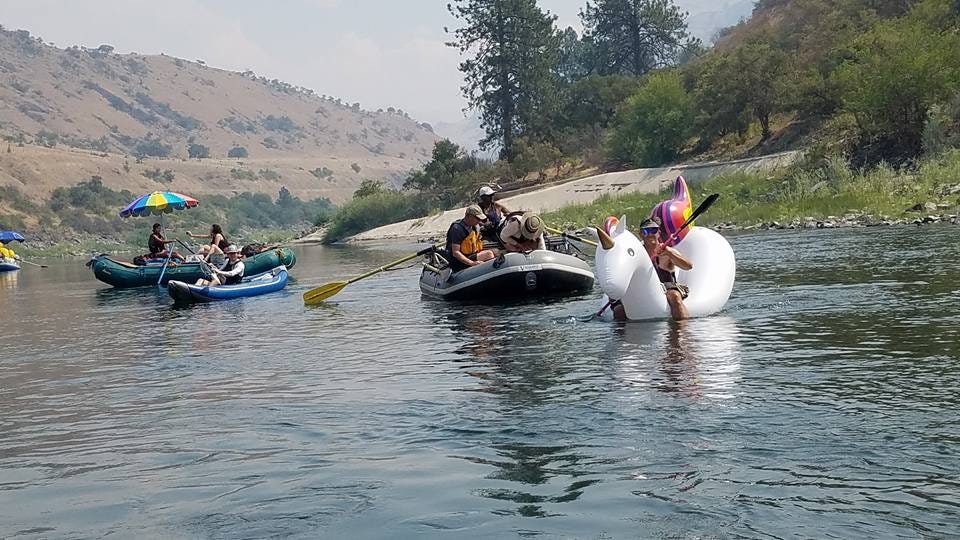
THE EVER VARYING FLOOD
In December of 2017, seven of us ventured Down Under to boat a river only one of us had ever heard of before this trip was planned. This is our story. It will take several ‘parts’ for me to tell it. I’ll post a ‘part’ each Sunday until the story - from my perspective - is complete.
Our small party of three under-sized rafts reached the Great Ravine sometime in the early afternoon. It was overcast and misty, but some of the mist was rising from the yawning declination that marked the entrance to the Franklin River’s highly respected and eminently dangerous gorge. Our lead raft had pulled into an eddy on river left just upstream of a significant cliff.
The river thundered out of sight.
We were about to be introduced to the crux section of whitewater in the Franklin River Gorge in Tasmania, Australia.
There were a few words regarding the Franklin that left an indelible impression on me just a few weeks before our journey and were messaged to me by a young, virile, male kayaker. It was clear by his social media profile he sought out danger and challenging water just for jollies. He also worked seasonally as a Franklin raft guide, and his words were, and I quote….
“It’s one of the only Class V rivers that still scares the shit out of me every trip.”
I would be lying if I reported that his words had not given me pause. Caused my heartbeat to tick up a notch. I had been thinking about and planning a river trip Down Under on the Franklin River for decades. But I knew precisely fuck all about the whitewater or the logistics of such a trip.
What I knew about the Franklin I gleaned from newspaper reports or National Geographic articles written during the late 70s when the youth of Australia decided to defend the river from those who were inclined to ‘lock it up’ behind a dam. Those in favor of the dam described the Franklin as “a brown, leech-ridden ditch.” (As it turns out, we learned both of those descriptors were true. The water was tannin-tainted brown and there were leeches. On land!)
It was my understanding the Franklin was Tasmania’s last major free-flowing river. Activists, who were determined to keep it that way, rallied for months encamped in the wilderness of the Franklin and Gordon Rivers, blocking the river with makeshift rafts and one-person inflatables and being carted off to jail for their insubordinate behavior and uncivil disobedience. Hundreds of protesters were arrested and incarcerated. I imagine leeches were a hot topic of conversation over those blazing campfires.
Even so, they persisted.
Today there exists the Franklin-Gordon Wild Rivers National Park which is part of the greater Tasmanian Wilderness World Heritage Area. Twenty per cent of the island state of Tasmania lies within its boundaries. A testament to the power of people speaking up and acting out.
But that was the extent of my knowledge of the Franklin. It was meant to be dammed. It was saved by a noisy group of tree-hugging, pot-smoking do-gooders.
Prior to my leaving for Tasmania in late November, and after learning that a hot shot boater who ate adrenalin for breakfast felt uncomfortable every time he boated the Franklin, I started actively seeking ‘real’ videos of the Franklin. Real videos as opposed to the videos disseminated by the commercial rafting companies that surely wanted to sugarcoat the hardships and the difficulty of the whitewater.
I studied these videos as if cramming for an exam. It was reassuring to see pack rafts negotiate a lazy Franklin River in late summer. Just as it was nerve wracking to watch groups wrestle and wrangle boats and gear beside a raging torrent or drag boats over colossal, slippery river side boulders during the peak season when flooding was common.
At this point, I knew we would have to portage or line a portion of the river regardless of our talents or inclination. We were going to be neck-deep in the wilderness. The front country and medical help were hundreds of miles away. The whitewater we chose to run would need to be whitewater we expected to be able to navigate. Pushing the envelope would be better saved for day excursions.
I also knew the river had a tendency to rise and fall at ‘the drop of a hat’. It was known to spike in just hours, filling its gorge, and then dissipate like a falling tide. The lines on the graph looked more like the mythical, make-believe peaks in a Tolkien novel than a normal water graph.
And that was why Tasmanians referred to it as the ‘ever varying flood’.
We were told the ideal levels on the online gauge were between one thousand and five thousand ML/day. Two days before we set out across Tasmania for the put-in site on the Collingwood River, the Franklin had peaked at twenty thousand ML/day. Forty eight hours later when we reached the Collingwood River launch the stream gauge indicated the Franklin was running at about one thousand ML/day.
Ever varying, indeed!
If you were not having to pick your way cautiously through The Great Ravine amidst a tumult of enormous obstacles and just as enormous whitewater, a little extra water volume sounded refreshing. And twenty thousand ML/day (whatever that was) might have been useful on the Collingwood - a tributary that crossed the Lyell Highway and made for a convenient and accessible starting point. (Reportedly - the upper reaches of the Franklin itself were too infested with unpredictable log jams in menacing gorges to be used as a launch site.)
What else did I know of the Franklin?
I learned in advance the river was deemed potable by Tasmanians despite its being inky blackish-brownish from tannins leached into the water. As a precaution, I purchased a water purifier - designed like a French coffee press - but the tannins clogged the filter after a few plunges and I abandoned it for the remainder of the trip. We rolled the dice and drank straight from the Franklin like native Tasmanians. Happy to be free of lugging forty pound water jugs down a river of crackling whitewater in tiny rafts.
But that was the extent of my knowledge in a nutshell.
When the seven of us boarded our respective flights for the island, which once served as England’s most distant penal colony known as Van Diemen’s Land, we were not as clueless as those unfortunate prisoners who were being deported thousands of miles from their homelands, but we certainly had some significant blind spots.
###
I want to thank Dane Doerflinger for the heading photo. It is a fantastic shot of our party having a relaxing lunch at the very place where a dam was proposed and where hundreds of tiny craft once gathered in protest of that dam.
What you cannot see in that photo is the relief I felt at reaching this particular section of the Franklin. It meant we were out of the whitewater ‘red zone’ and were entering a much more leisurely stretch of our trip.
But not THIS leisurely.

Also, I have multiple news aggregators, newsletters and subscriptions coming into my inbox these days that are great for keeping my finger on the pulse of what’s going on. I’ve mentioned many of them. Well, here’s another.
This morning’s content included a story about Bill Laimbeer, once one of the Detroit Pistons bad boys and his circuitous journey to becoming a damn good WNBA coach, in spite of the fact he liked to refer to it as “ladies” basketball.
Another story was about cognitive ability and vulnerability to “fake news”.
Good shit, Maynard!




